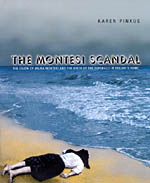"When the body of Wilma Montesi—an 'Anygirl,' Karen Pinkus calls her—washed up on a beach outside Rome in 1953, the police ruled her death accidental, but the case soon took on a life of its own, exploding in the newspapers in a storm of rumors. Pinkus's ingenious book . . . tracks the case in screenplay format, including cast of characters, dialogue, and detailed notes on shots and settings. Gorgeously designed and illustrated, it seems to invent a new genre: the movie never meant to be made."—The New Republic Online
"Pinkus brings a Hollywood sensibility to the Montesi story. She hews to the scandal's basic chronology, yet adds flourishes that make the press coverage and trial transcripts come alive. . . . It is actually hard to imagine a better format to situate the Montesi scandal in the context of the Italy of Fellini's paparazzi and Pasolini's soulless postwar apartment complexes, of back-room-dealing Christian Democrats, Fiat 600s, dance halls, and tabloid magazines. Ms. Pinkus hasn't uncovered any new evidence, but she has masterfully made her medium her message: a collage that mirrors the scandal itself, where fragmented truths don't cohere into a whole and tabloid images take on a life of their own, beyond the foggy reality of whatever happened."—Rachel Donadio, New York Sun
An excerpt from
The Montesi Scandal
The Death of Wilma Montesi and the
Birth of the Paparazzi in Fellini's Rome
by Karen Pinkus
The Two Plausible Hypotheses
Friday, April 17. A week after Wilma's disappearance the case is officially solved and is set to be "archived," pending receipt of the medical reports and completion of all paperwork. Police put forth two plausible hypotheses, each with its own logical intricacy:
1. Suicide. But Wilma had not shown any apparent signs of depression—after all, she was engaged to be married and sent her fiancé cheerful postcards, whose contents she also dutifully copied into a notebook. And why would she have taken her house keys, or meticulously washed her undergarments that very morning, or removed her garter belt at the beach, if she meant to take her life? (Police determined the force of the tide was not enough to remove it—no easy task, as one medical expert testified, nostalgically recalling his adolescent training in this area. In fact, the sea, although rough, had not been strong enough to remove Wilma's little jacket fastened by only one button near the collar). And why go all the way to Ostia, or even to the private beach at Tor Vaianica, where she was actually found, when the Tiber River, right in the heart of the city, had well served many young girls determined to take their lives?
2. Drowning by "misfortune" (disgrazia). But how could a healthy girl of eighteen drown in ankle-deep water? And if Wilma had merely gone to bathe her feet, then again, why remove the entire garter? Why not simply unclip the stockings? Finally, if this footbath and drowning did take place in Ostia, how did the corpse end up approximately twenty kilometers away in Tor Vaianica?
Let us review. Ostia/public beach/public transport = good Wilma; Tor Vaianica/private beach/private conveyance = bad Wilma.
Finally, police cannot fully rule out homicide. Someone—a "brute" as the cronaca liked to say—may have dumped the body at the beach. It is possible that Wilma was still alive, but unconscious at that time. In any case, the final cause of death was, unequivocally, drowning.
Various shots of groups of Romans reading papers at bars and discussing Wilma Montesi's death.
 Wilma's tomb adorned with the famous headshot. (Olympia Publifoto, Milan) [Full-size image] | |
Died April 9, 1953 [Actually, this is the day of her disappearance, not necessarily the day she died]. Pure creature of rare beauty, the sea at Ostia carried you away to leave you on the beach at Tor Vaianica—it seemed as though you slept the sleep of God, beautiful as an angel. Your mother, your father, your sister and your brother are near you in their great love and immense suffering.
During the procession through the cemetery Zio Giuseppe insistently asks a journalist named Doddoli about the progress of the police investigation.
"Why are you so concerned?" Doddoli asks aggressively. "Did you have something to do with it?"
"Please. Leave me out of it," Zio Giuseppe begs. The scene must be ambiguous, as is the emotional intensity of Zio Giuseppe's response.
April 20. Three days after the funeral, the Messenger publishes an unsigned article titled "In the Margins of the Tragic End of the Young Wilma Montesi." Later, we will learn that the cronista following the case for this paper is actually Fabrizio Menghini, the same individual who presented himself as a lawyer in order to observe the initial inspection of the body at Pratica del Mare. This explains how the Messenger had been able to provide a detailed description of the body and implicate itself in the family's identification. The article suggests that while journalists (including the author himself) have responsibly (and "democratically"!) reported on the facts given them by police spokesmen, the average man on the street believes that the case was closed much too swiftly. All of Rome talks of the exquisite corpse on the beach, and no one is convinced by either the suicide or the disgrazia theory.
Shots of various groups of Romans discussing the case.
Then, unexpectedly, on April 22, journalists are granted a meeting with the chief of the "flying squad," the branch of civil police initially in charge of the investigation, formed after the war by a politician named Mario Scelba. Scelba has recently been promoted to minister of the Interior and he oversees all of the police. A Christian Democrat, he is to the far right on the political spectrum. He is also friendly with rich and famous individuals, including a dapper Sicilian hunting preserve manager, as we will see later. Let us note, for now, that it was Scelba's "flying squad" that dismissed the possibility of homicide and declared the death accidental.
Shot of police announcing results of their investigation as reporters eagerly take notes:
 Courtyard of Wilma's building with an arrow indicating her apartment. [Full-size image] | |
To some degree, the whole case at this point hinges on the question of the garter belt. Wilma's father gives detailed testimony, noting that his daughter always wore a simple, 20 cm long band of black silk around her waist. As it moved toward the back, the band diminished in size until it was about the width of the elastic itself—6 cm. On the left side there were 5 fasteners. Wilma only wore the garter when she went out. She did all the fasteners for fear the garter might slip off. Our viewers may be struck by the intimate knowledge Wilma's father seems to possess about his daughter's garter. At other points in our film, however, he will appear detached, out of touch with Wilma's desires. A former maid contradicts Rodolfo, noting that Wilma actually wore a one-piece bra-girdle-suspender belt, fastened so tightly that the maid had to help her put it on and take it off. Clearly, a full-piece would be removed by the tide only with the utmost difficulty, and not without dragging off the victim's shirt or sweater. On the other hand, one might understand that Wilma would remove such a restrictive garment (were she actually wearing it) in order to enjoy greater freedom of movement on the beach. Wanda testifies that her sister would never have taken off her suspender belt on a public beach unless she felt so sick that she absolutely had to—in extremely hot weather, for example. Who can legitimately speak to the particulars of Wilma's undergarments, her peculiar habits, her tics? Her father seems to have the last word, like a stern voice-over dubbed over an ambiguous scene in a narrative film, but should his authority over her most prosaic manners be questioned?
As Fabrizio Menghini notes in his unsigned piece in the Messenger, the police version of events has not convinced the public. The paper has already begun to receive many letters from all over the country, including one that states: "A man opened the gate of the old royal hunting reserve (Castel Porziano) for a car which had entered the other gate at Capracotta [sic—this means "cooked goat"; as we will soon learn, the estate in question is actually called Capocotta, "cooked head"] with a man and a woman on board. The person who observed this may even know the name of the driver, and has recognized the dead woman in the photographs published in the papers as the very passenger in that car."
 There can be little doubt that Fellini had Wilma's body and its aftereffects in mind when he conceived of the final scene of La dolce vita. Stunned jet-setters on the morning after a striptease/orgy view a monstrous fish washed up by the high tide. [Full-size image] | |
Capocotta had long been a royal hunting ground, retooled in the postwar era as a private club for wealthy gentlemen. A vestige of the monarchy, Capocotta posed uncomfortable questions for the democracy. It was a sort of no-man's-land, neither private property nor land with free public access. Stocked with game like the lavish reserves of Renaissance princes, Capocotta was a potential target for critics who delighted in accusing the ruling class of profiting from antiquated forms of social connection. To enter this magical terrain, one had to be invited, and most important, it gave access to the sea. Surrounded by fences and protected by tall trees, Capocotta was a breeding ground for ambivalence and paranoia in the developing democracy. To this day, it has retained something of its regal aura: it is the property of the Italian president.
Under pressure from the press and the public, the police agree to conduct a second "informal" investigation (i.e. without involving the judiciary branch, since no criminal act is suspected) into Wilma's death. This second investigation will last for months, and will reach the same conclusion as the first.
Copyright notice: Excerpt from pages 28-33 of The Montesi Scandal: The Death of Wilma Montesi and the Birth of the Paparazzi in Fellini's Rome by Karen Pinkus, published by the University of Chicago Press. ©2003 by The University of Chicago. All rights reserved. This text may be used and shared in accordance with the fair-use provisions of U.S. copyright law, and it may be archived and redistributed in electronic form, provided that this entire notice, including copyright information, is carried and provided that the University of Chicago Press is notified and no fee is charged for access. Archiving, redistribution, or republication of this text on other terms, in any medium, requires the consent of the University of Chicago Press and of the author.
Karen Pinkus
The Montesi Scandal: The Death of Wilma Montesi and the Birth of the Paparazzi in Fellini's Rome
©2003, 180 pages, 46 halftones, 7 x 8½
Cloth $27.50 ISBN: 0-226-66848-7
For information on purchasing the book—from bookstores or here online—please go to the webpage for The Montesi Scandal.
See also:
- Our catalog of books in literary studies
- Our catalog of books in film studies
- Other excerpts and online features from University of Chicago Press titles
- Sign up for e-mail notification of new books in this and other subjects
